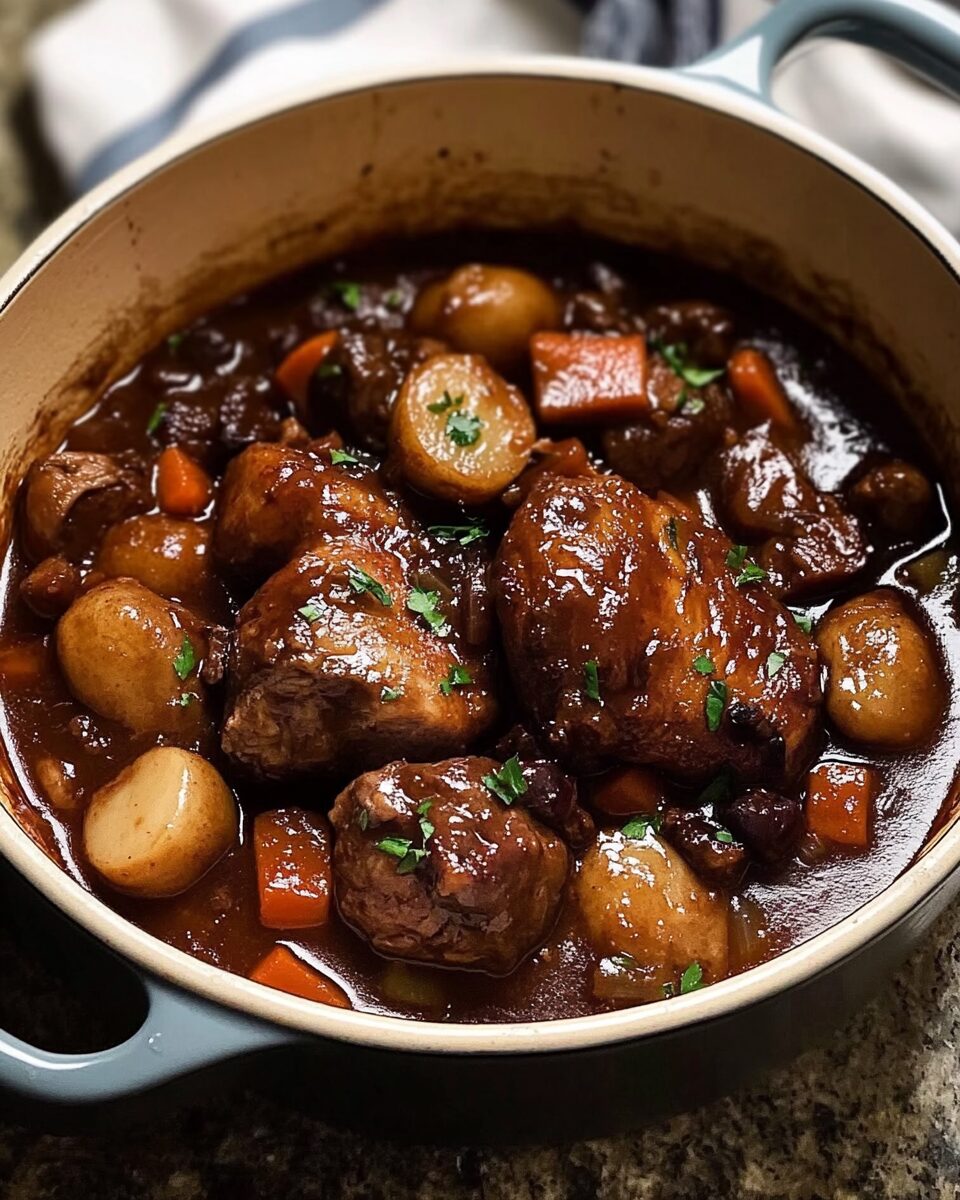Coq au Vin is a classic French stew that transforms humble chicken pieces into a luxurious feast. The chicken is marinated overnight in red wine, which infuses deep flavors, then braised slowly until tender in a rich, savory sauce made with wine, bacon, and mushrooms. The result is a dish that’s layered in flavor and aroma, truly worthy of a special occasion or dinner party.
This recipe, while simple in its ingredients, stands out because of the love and time put into marinating and braising. Serve it over mashed potatoes or pasta to soak up all that luscious sauce, and pair it with a glass of red wine for an authentic French bistro experience at home.
Full Recipe:
Chicken Marinade:
- 4 chicken thighs (bone-in, skin-on)
- 4 chicken drumsticks
- 16 pearl onions or pickling onions
- 1 bay leaf
- 3 thyme sprigs (or 1 tsp dried thyme)
- 750 ml (3 cups) Pinot Noir or other dry red wine
For Coq au Vin Stew:
- 400g (14oz) white mushrooms, halved (quartered if large)
- 150g (5oz) bacon, cut into 1 x 2.5cm batons
- 60g (4 tbsp) unsalted butter
- 3 garlic cloves, minced
- 2 tbsp tomato paste
- 7 tbsp plain/all-purpose flour
- 750 ml (3 cups) beef stock (preferably homemade, low sodium)
- 3/4 tsp salt (or as needed)
- 1/2 tsp black pepper
Garnish and Serving:
- 2 tbsp parsley, chopped
- Mashed potato or tagliatelle pasta
Directions:
- Marinate Chicken:
Mix chicken thighs and drumsticks, pearl onions, bay leaf, thyme, and wine in a large glass or ceramic bowl. Marinate overnight in the fridge (minimum 12 hours, up to 24 hours). - Reduce Wine:
Strain wine into a pot and reduce by half over medium-high heat. Set aside. - Dry and Brown Chicken:
Remove chicken and pat dry. Heat oil in a large oven-proof pot over medium-high heat. Brown chicken on both sides until deep golden, about 2-3 minutes per side. Remove to a tray. - Sauté Bacon & Vegetables:
Cook bacon in the same pot until golden, then set aside. Sauté mushrooms until lightly browned, remove, and set aside. Add more oil if needed, then cook onions for about 5 minutes until golden patches appear. - Build Stew Base:
Add butter to the pot, melt, then add garlic and cook for 1 minute. Add tomato paste and cook for 2 minutes. Sprinkle flour and cook for another 2 minutes. - Combine and Cook:
Slowly pour in beef stock while stirring, then add the reduced wine. Mix until flour dissolves. Add browned chicken, bacon, mushrooms, thyme, and bay leaf back into the pot. Stir and bring to a simmer. - Oven-Braise:
Cover and transfer to a preheated oven at 180°C / 350°F (160°C fan) for 45 minutes. - Adjust and Serve:
Taste and add salt if needed. If sauce is too thin, simmer on the stove to thicken. Serve over mashed potatoes or tagliatelle, garnished with fresh parsley.
Prep Time: 15 minutes | Cooking Time: 45 minutes | Total Time: 1 hour
Kcal: 977 kcal | Servings: 4-5 servings
The History and Tradition Behind Coq au Vin
Coq au Vin, which translates to “rooster in wine,” is a traditional French dish that dates back centuries. It originated as a rustic farm dish, traditionally using an older rooster for its rich flavor and firm meat. Over time, it has evolved into a refined and elegant dish, often served in French bistros and fine dining establishments. Today, chicken is most commonly used as it’s more accessible than rooster, but the essence of the dish remains the same: a slow-braised stew cooked in red wine, flavored with herbs, bacon, mushrooms, and aromatic vegetables.
Flavor Profile and Preparation
The deep and complex flavor of Coq au Vin is all about the interplay of its simple ingredients. The chicken is marinated in red wine, typically Pinot Noir, which gives the meat a depth of flavor and helps tenderize it. The red wine also forms the base of the sauce, which becomes rich and glossy after being braised. The addition of herbs like thyme and bay leaf, along with pearl onions and bacon, creates a stew that is earthy, savory, and slightly smoky. The mushrooms add another layer of flavor and texture, soaking up the sauce and becoming tender yet firm.
This dish is truly a celebration of simple ingredients elevated by careful cooking techniques. The marinating and slow-braising ensure that the flavors meld beautifully, and the sauce thickens into a velvety, luxurious texture. It’s a perfect example of how French cuisine can take humble ingredients and transform them into something truly special.
Cooking Tips and Variations
- Marinating for Flavor: The key to the best Coq au Vin is marinating the chicken in the red wine for at least 12 hours, up to 24. This step is crucial for infusing the chicken with flavor and helping it become tender as it braises.
- Red Wine Choice: While Pinot Noir is traditional, you can use any medium-bodied red wine that is not overly tannic or full-bodied. Affordable wines work perfectly since the flavors deepen and mellow during cooking.
- Stock Selection: The choice of stock plays a role in the depth of flavor. While beef stock is traditional to create a rich, dark sauce, chicken stock can be used for a lighter version, although the color and depth of flavor will be milder.
- Cooking Methods: Braising in the oven is preferred for even cooking, but you can also simmer on the stovetop if you monitor the temperature. The goal is to keep the stew gently bubbling without boiling too vigorously.
Serving Suggestions
Coq au Vin is best served with starchy sides that can soak up the flavorful sauce. Here are some classic and creative options:
- Mashed Potatoes: Creamy mashed potatoes make an excellent pairing, balancing the bold flavors of the stew with their smooth, buttery texture.
- Tagliatelle or Pappardelle Pasta: The wide, flat noodles are perfect for capturing the sauce, creating a comforting, pasta-based meal that feels like French-Italian fusion.
- Rice or Quinoa: For a lighter side, rice or quinoa can also work well to soak up the sauce while providing a different texture.
- Crusty Bread or Brioche: Warm, crusty bread is a classic choice. It’s perfect for mopping up every drop of the sauce, making sure none of that delicious flavor goes to waste.
Pairing and Presentation
For a complete French-inspired dining experience, pair your Coq au Vin with a glass of the same red wine used in the dish, ideally a Pinot Noir or a similar medium-bodied wine. A simple green salad dressed in a lemony vinaigrette will help to balance the richness of the stew, cleansing the palate between bites.
For presentation, serve the chicken pieces on a bed of mashed potatoes or pasta, ladle the sauce generously over the top, and sprinkle with fresh parsley for a pop of color. The rustic appearance of the chicken, with its golden brown skin and rich, dark sauce, makes for an enticing, homey dish that brings the flavors of French bistro cooking to your table.
The Regional Variations of Coq au Vin
While the traditional Coq au Vin is made with a red wine from Burgundy, there are actually several regional variations of this dish across France, each using local wines and ingredients. For example:
- Coq au Vin Blanc: This version uses a white wine instead of red, typically from the Alsace or Jura regions. The sauce becomes lighter in both color and flavor, with a slight tanginess that sets it apart.
- Coq au Riesling: A variant of Coq au Vin Blanc, but specifically using Riesling, a popular wine from the Alsace region. This variation is creamier, with a touch of sweetness from the wine.
- Coq au Champagne: Made with champagne or sparkling wine, this variation has a luxurious touch, perfect for festive occasions. It’s typically accompanied by a creamy sauce that’s lighter than the traditional red wine version.
- Coq au Vin Jaune: A specialty from the Jura region, this dish is made with “Vin Jaune” (yellow wine), a local wine similar to dry sherry. The flavor is distinctively nutty, which pairs beautifully with mushrooms and morels.
The Importance of the Wine-Reduction Step
One of the key techniques in making Coq au Vin is reducing the wine before braising. This step intensifies the flavors and removes the harsh edge from the alcohol, ensuring a smooth, rich sauce. Skipping this step may result in a sauce that’s overly wine-forward and lacks the desired depth of flavor. The reduction also ensures that the dish doesn’t become too watery, concentrating the flavors to balance the earthiness of the mushrooms and the smokiness of the bacon.
Getting the Perfect Texture and Flavor Balance
Coq au Vin is all about achieving the right texture for both the chicken and the sauce. Here are some tips to ensure the dish comes out perfect every time:
- Chicken Texture: The chicken should be tender yet firm, not falling off the bone. Using bone-in, skin-on thighs and drumsticks is ideal as they are more forgiving during long braising than chicken breasts, which can dry out. Make sure to brown the chicken well before braising; this step adds a caramelized flavor and helps lock in the juices.
- Sauce Consistency: The sauce should be thick enough to coat the back of a spoon but not overly thick like a gravy. If it’s too thin after braising, simmer it on the stovetop without the lid to reduce it until it reaches the desired consistency. Flour helps thicken the sauce, but the reduction of the wine and stock is where the rich flavor comes from.
- Balancing Salt and Flavor: Since bacon adds saltiness to the dish, it’s best to season conservatively during cooking and adjust the salt at the end, tasting the sauce as you go.
Preparing Coq au Vin in Advance
One of the beauties of Coq au Vin is that it’s a dish that improves with time, making it an excellent make-ahead recipe. Here’s why preparing it in advance works well:
- Flavor Development: Letting the stew sit overnight allows the flavors to meld together and deepen. The wine’s acidity mellows, and the sauce becomes more complex.
- Reheating Tips: Reheat the stew slowly over low heat to avoid overcooking the chicken. If the sauce thickens too much in the fridge, add a little water or stock while reheating to loosen it up.
Pairing Coq au Vin with Side Dishes and Drinks
- Sides Beyond Mashed Potatoes: While mashed potatoes and pasta are traditional pairings, creamy polenta is a delicious and comforting alternative. It provides a buttery, smooth base to soak up the sauce, offering a different texture than potatoes or pasta.
- Vegetable Sides: For a complete meal, consider serving Coq au Vin with simple vegetable sides that won’t overpower the flavors of the stew. Some great options are:
- Roasted Brussels Sprouts or Green Beans Almondine: A touch of nuttiness and crisp texture contrast nicely with the rich sauce.
- Glazed Carrots or Parsnips: Their natural sweetness complements the savory depth of the Coq au Vin.
- Wine Pairing: If you’ve used Pinot Noir in the recipe, serve it alongside the dish for a perfect pairing. Other red wines like Merlot or Cabernet Sauvignon also work well. If you’ve made a white wine variation, serve a dry Chardonnay or a slightly fruity Riesling to balance the flavors.
Adapting Coq au Vin to Your Dietary Preferences
While the traditional Coq au Vin is a meat lover’s dream, the recipe can be adapted for various dietary preferences:
- Gluten-Free Version: To make the dish gluten-free, substitute the flour used for thickening the sauce with a gluten-free all-purpose blend or cornstarch. Ensure that the stock and bacon used are also gluten-free.
- Vegetarian Coq au Vin: For a vegetarian version, replace the chicken with hearty vegetables like portobello mushrooms, carrots, and potatoes. Use vegetable stock instead of beef stock, and add a splash of soy sauce for umami depth. The cooking process remains the same – marinate the veggies in wine, then braise them slowly to develop flavor.
Serving Coq au Vin for Special Occasions
Coq au Vin is a dish that brings a touch of elegance to any dinner table, making it a great choice for special occasions, dinner parties, or cozy gatherings. Since the dish can be prepared in advance, it allows you to focus on entertaining guests instead of being stuck in the kitchen. Serve it with a nice table setting, a few candles, and a bottle of good wine to transport your guests to a French bistro.
Tips for Making a Show-Stopping Presentation
- Garnishes Matter: Chopped parsley adds a fresh burst of color against the dark sauce and enhances the dish visually.
- Use a Nice Serving Dish: Serving Coq au Vin in a rustic Dutch oven or cast-iron pot adds to the homey feel of the dish. Alternatively, you can use a large serving platter with a lip to keep the sauce from spilling.
- Add Finishing Touches: A drizzle of extra virgin olive oil or a few sprigs of thyme on top of the dish right before serving enhances the aroma and gives a polished look.
Interesting Facts about Coq au Vin
- Ancient Roots: Though Coq au Vin has evolved into a refined French dish, its origins are thought to date back to the Roman Empire. Legend has it that Julius Caesar once sent a bottle of wine to a village he was conquering, and they cooked a rooster in it as a gesture of acceptance.
- Cook Like the French: In French households, Coq au Vin is seen as a family recipe passed down through generations, with each family adding their unique touch. Some may add carrots, while others swear by a different type of wine.
- A Dish for All Seasons: Although Coq au Vin is often seen as a fall or winter dish because of its rich flavors, it can be enjoyed year-round. Lighten it up in warmer months by pairing it with fresh green salads and serving with a chilled white wine.
Conclusion
Coq au Vin is a timeless French classic that beautifully marries simple ingredients with sophisticated flavors. Its rich, wine-based sauce, tender chicken, and aromatic herbs make it a comforting yet elegant dish perfect for any occasion. Whether you’re hosting a dinner party, celebrating a special occasion, or simply craving a hearty meal, Coq au Vin brings the flavors of a French bistro right to your table. Simple to prepare and even better when made ahead, this dish is sure to impress and satisfy all who taste it.





